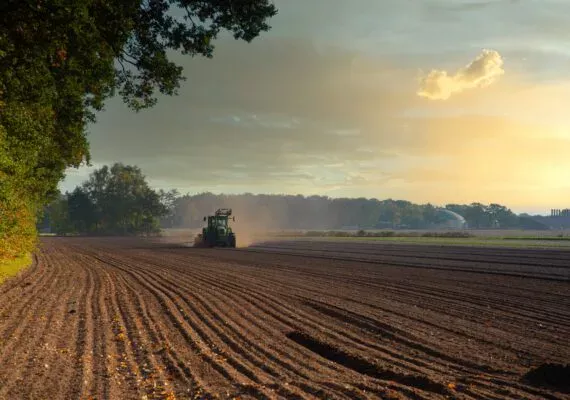
HOW TO MANAGE THE DECOMPOSITION OF CROP RESIDUES?
Utilizing crop residues can reduce costs associated with fertilizing fields with mineral fertilizers and increase soil fertility. The decomposition of crop residues is a long-term process dependent on the biological activity of the soil, namely the content of beneficial soil bacteria. This process can be accelerated by using nitrogen or calcium. The latter solution is becoming increasingly popular and less costly.
Decomposing straw releases phytotoxic substances. Under aerobic conditions in the soil, these substances are harmless to plants. Unfortunately, during wet autumn conditions, anaerobic conditions can occur in the soil, increasing the toxicity of phytotoxic compounds and the possibility of fungal diseases. Applying calcium to decomposing straw limits their development. Additionally, calcium raises the soil pH, making the nutrients in it more accessible to plants. This promotes more abundant soil microbiological activity and improves soil structure.
WHEN SHOULD WINTER GRAINS BE SOWN?
The appropriate sowing time for winter grains is crucial for the entire plant’s vegetative period. Depending on the region of Poland, this period will vary in length. Therefore, official dates have been established for sowing winter grains in fields. However, depending on changing weather conditions, these dates may shift. It is erroneous to sow winter grains too early because it leads to excessive plant tillering. Sowing them too late is also improper, as the grains may not reach full development before winter.
Barley is the first and most delicate winter grain sown in autumn. It is sown at the following times:
- from September 5th to 15th in the eastern and northeastern parts of Poland;
- from September 10th to 18th in the central part of Poland;
- by September 20th in the western and southern parts of Poland.
Winter rye is very popular. It grows well on many soils and is sown from September 5th to 20th. In the central part of Poland, it can be sown even until the end of September. In the west and south of the country, sowing begins on September 20th and can last until October 5th. Winter rye should be sown to a depth of 2 to 4 cm.
Winter wheat has the smallest soil requirements. It also has specific sowing times:
- from September 5th to 15th in northeastern Poland;
- until September 25th in central and southeastern Poland;
- from September 20th to 30th in western Poland;
- from October 1st to 7th in Western Pomerania.
The last type of winter grain is winter wheat, also known as the queen of grains. It is extremely important to sow it at the specified time due to its high delicacy. Winter wheat is sown:
- from September 5th to 20th in northeastern Poland;
- from September 10th to 25th in central and southeastern Poland;
- in the second half of September in western Poland;
- from September 20th in the Silesian Lowland.
HOW TO FERTILIZE FIELDS UNDER WINTER GRAINS?
Wheat is a plant that requires proper fertilization, so improving soil quality is necessary to provide an environment that supports its growth. Wheat grows well at a pH of 6.0 to 6.8 – this is the optimal soil pH for wheat.
To ensure proper development, wheat requires macro- and micronutrient fertilization, including:
- phosphorus;
- nitrogen;
- sulfur;
- potassium;
- magnesium;
- calcium;
- iron;
- manganese;
- copper;
- boron;
- zinc;
- molybdenum.
Nitrogen fertilizers for winter wheat fields are applied in one dose in autumn and two to three doses in spring. Phosphorus fertilizer should be applied in autumn in the form of protected phosphorus or as superphosphate.
It is also necessary to apply sulfur and calcium-magnesium fertilizers, such as granulated magnesium lime, and fertilizers with micronutrients.
To determine the appropriate fertilizer dosage, a soil laboratory analysis must be performed. This will determine the soil’s nutrient content and pH.
It is worth noting that the optimal pH for winter grains is as follows:
- winter barley 6.0–7.0;
- winter rye 5.0–5.5;
- winter wheat 5.5–7.5.
WHAT SPRAYS TO USE ON WINTER GRAINS?
Winter grain crops are extremely sensitive to weeds. Therefore, it is necessary to use herbicides during the field preparation process. Spraying with an herbicidal agent is best done in autumn. This will protect winter grain crops from the competitive and harmful effects of weeds on cultivation.
LIMING WHEAT FIELDS
Liming wheat fields is necessary because this plant cannot grow in soil with a low pH. Additionally, calcium is an essential element for wheat to grow properly. If it is lacking in the soil, the plants will not develop well or absorb other macro- and micronutrients, even if they are present in the soil. Therefore, liming has a significant impact on wheat yields.
Only after performing laboratory analysis, assessing the soil’s pH, and determining its deficiencies should liming be initiated. If in addition to calcium deficiency, a magnesium deficiency is also found, granulated magnesium lime SuperMag or a powdered form product such as Radkowit can be used. If there is no magnesium deficiency, simply using limestone to enrich the soil with calcium and adjust the pH level is sufficient.
Liming for winter grains can be done in spring (preceding the sowing of winter grains) or autumn. In the spring period, this treatment should be performed at least a month before planting or sowing the first plants, which will serve as pre-crops for winter grains. For autumn liming, a one-month interval between liming and sowing winter grains should also be observed. It is also important to maintain a six-week gap before using other fertilizers. This mainly applies to phosphorus and nitrogen fertilizers, as well as manure and slurry.






